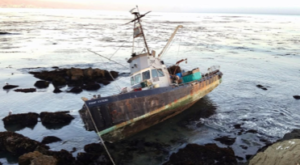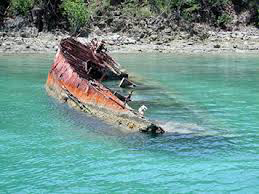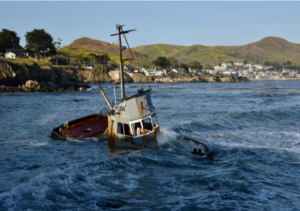Heal The Ocean Convenes Boat Wreckage Task Force
Santa Barbara Edhat 1/21/2022
‘Dead’ derelict boats pulled from Goose Spit K’omoks First Nation harbour MyComoxValleyNow 01/17/2022
Derelict Vessel Removal Program A Success In Improving Everett’s Waterways MyEverettNews 01/12/2022
Key approval granted for removal of grounded American Challenger off Marin coast The Press Democrat 01/11/2022
NOAA’s series of webinars on ADVs is still available for viewing. The nine recorded webinars are available here: “Salvaging Solutions to Abandoned and Derelict Vessels”
The Task Force has created a digital toolkit for ADV outreach and prevention education. Click here to access the tools.
ABANDONED AND DERELICT VESSELS

Abandoned and derelict vessels (ADVs) are a growing global problem that harm aquatic health and the health of humans and wildlife; threaten commerce and navigation safety; and deplete resources that communities depend upon.
Through deliberate action or negligence, ADVs break up, sink, or block navigation channels. ADVs often contain harmful quantities of oil, lubricant, and toxic substances found in the cargo or in the materials used to construct the vessel. These chemicals can injure or kill marine mammals, waterfowl and other aquatic life, and contaminate shorelines. Vessels that settle on the bottom can disrupt the aquatic environment, scouring or crushing sensitive habitats such as eelgrass beds and kelp meadows. In addition to the damaging environmental impacts, the cost, scale, and lack of policy to address this issue leave many of these vessels in waterways.

THE ADV WORKGROUP
The Pacific States / British Columbia Oil Spill Task Force identified the issue of ADVs as a common threat and a critical, emerging issue in 2017. In 2018, the Task Force formed an ADV Workgroup comprised of ADV experts and program leads from each of the five United States Task Force jurisdictions: Alaska, California, Hawaii, Oregon, and Washington.
WHITE PAPER
The ADV Workgroup’s initial task was to document the scope and scale of the problem of ADVs across each jurisdiction. In March 2018, the ADV Workgroup published The Current State of Abandoned and Derelict Vessels on the West Coast – White Paper (pdf) summarizing the results of this initial work.

THE ADV BLUE RIBBON PROGRAM
In 2020, the workgroup presented a blue-ribbon, model program with recommendations that may be implemented by West Coast states to address their own ADV issues. These recommendations focus on five key elements identified as important for a successful program to address ADVs: authority; prevention; public outreach and education; removal and deconstruction; and funding. Follow this link to view the final Blue-Ribbon Report (pdf).
For more information on our ADV related work, please contact the Chair of the ADV Workgroup, Hilary Wilkinson, Hilary@VedaEnv.com.
LISTEN to Hilary Wilkinson’s Conservation Cafe Podcast episode on ADV’s
Stop the Steel: How Oregon’s Clean Marina Program is Eliminating Abandoned and Derelict Vessels
Conservation Cafe
Abandoned and derelict vessels are on the rise in marinas and waterways across the west coast. These unsightly, unseaworthy boats can create costly headaches for marina managers, burden taxpayers, block federal navigation channels, and harm wildlife and habitat. Join Hilary as she talks with Glenn Dolphin, Clean Marina Program Coordinator for the Oregon State Marine Board, about a successful effort to prevent new abandoned and derelict vessels through an innovative partnership with marina managers.
Listen on Apple Podcasts: https://podcasts.apple.com/us/podcast/conservation-cafe/id1572342247?i=1000545306103